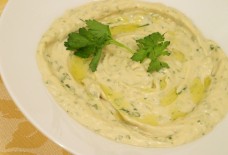The Moroccan Tapestry: 7 Types of Moroccan Embroidery

By: Maryem Bouatlaoui / Arab America Contributing Writer
From dresses to couches to Ottomans, embroidery is essential to Moroccan culture. Across the country lie variations of embroidery, differing in style, color, and symbolism. Drawing from local traditions and foreign influence, the Moroccan region holds its own type of emblematic embroidery. This article outlines some of the most popular forms of embroidery in Morocco.
1. Fes (Tarz el Fassi)

Fes’ embroidery, also referred to as Tarz el Fassi, is the most well-known type of embroidery in Morocco. Tarz el Fassi, contrary to popular belief, is not indigenous to Morocco; it comes from France. The French introduced the Tarz el Fassi to the Moroccan population after World War I to recultivate the local arts and crafts tradition in Morocco. Young girls would learn how to embroider Tarz el Fassi in schools, after-school programs, and at home with their relatives.
Tarz el Fassi uses a double-lining stitch, creating two-sided tapestries usually in red, blue, or green on white linen. Tarz el Fassi’s geometric floral designs can be found on Moroccan cloth napkins, tablecloths, and furniture covers. Caftans embroidered in Tarz el Fassi have also become essential to Moroccan weddings.
2. Rabat

Rabat, the capital of Morocco, is home to one of the most unique and vibrant types of embroidery in Morocco. Popular theory traces back the origins of Rabat’s embroidery to Spain, more specifically, the Moorish population. It is said that Moorish exiles from Spain settled in Northern Morocco and introduced unique Spanish embroidery elements to Moroccans.
Rabat’s embroidery, in contrast with Tarz el Fassi, is much more maximalist. The designs consist of large, colorful floral patterns. The flowers are mainly pink, red, purple, or yellow, and are usually embroidered onto white cotton cloth.
3. Chefchaoun

Chefchaoun, the blue city of Morocco, has a similar embroidery style to Rabat. Given its location in the north of Morocco, Chefchaoun’s embroidery is also heavily influenced by Spanish culture.
Chefchaoun’s embroidery is vivid and colorful, embracing tones of orange, blue, red, and yellow. Most pieces from Chefchaoun adorn a floral hexagonal geometric centerpiece and rectangular color blocks on either side, creating intricate vertical designs across linen fabric. This type of embroidery is usually worn at weddings as a chest centerpiece on top of a caftan.
4. Meknes

Meknes’ embroidery is quite similar to Tarz el Fassi, given the close proximity of the two cities in the inland part of northern Morocco. Meknes’ embroidery, however, is an amalgamation of Tarz el Fassi and Amazigh influence.
Embroidered pieces from Meknes are usually sewn in multiple colors on beige fabric. Designs begin with a central square design with embroidered roots taking form beyond the center and forming a larger embroidered square.
5. Tetouan

Tetouan’s embroidery is one of a kind, known for its vibrance and multicolor designs. Tetouan is located in northern Morocco, drawing a lot of its artistic influence from Spain.
Tetouan’s embroidery contains a collage of flowers in different colors, ranging from yellow to orange to blue to pink. The design has an abstract asymmetrical feel to it with sharp edges and jagged petals. More often than not, the designs are embroidered on bright yellow fabric.
6. Azemmour

Azemmour’s embroidery is different than the previous styles of Moroccan embroidery. Rather than floral patterns, Azemour’s embroidery is of animals, plants, and other natural elements. Azemmour’s embroidery has been compared to Spain’s Toledo embroidery as well as Italy’s Assisi’s embroidery.
Designs would usually depict animals such as small birds, and peacocks, and plants such as trees and flowers. While antiquated, Azemour’s distinct embroidery style offers an insight into the reflection of natural life in the arts.
7. Gnaoua

Gnaoua refers to an ethnic group in Morocco with ancestral ties to West Africa. The Gnawa have a distinctive musical tradition, blending classical Sufi melodies with pre-Islamic African folk tradition.
During Gnaoua musical performances, performers wear distinctive Gnaoua caps adorned with shells and a long tassel. The shells usually form simple star shapes across the cap and a rim across the brim of the cap. The shell embroidery can also be seen in sashes worn by Gnaoua performers. The sounds of the shells are also a musical element to Gnaoua’s performances.
Morocco is home to one of the most diverse landscapes of embroidery. From flowers to birds to shells, embroidered Moroccan pieces tell the story of a polyphonic cultural identity cultivated by a myriad of cultural influences.
Check out Arab America’s blog here!









